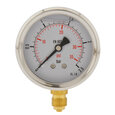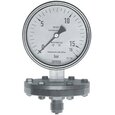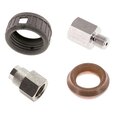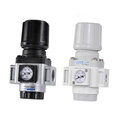Air Compressor Gauge

Figure 1: Air compressor gauge
An air compressor is a pneumatic device that creates pressurized air for a system. The motor typically requires electricity or internal combustion to operate. An air compressor gauge is a device used to display the pressure of compressed air in the system. It is advantageous to know the pressure created by the air compressor to not over-pressure the system and know it’s at the application’s specifications. To learn more about the inner workings of pressure gauges, read our pressure gauge overview article.
Gauges in industrial air compressors
Typically, air compressors used for industrial applications have two pressure gauges to indicate the PSI level of the two key stages in the pressurization process. One of them is the pressure gauge to indicate the air pressure in the tank. The other pressure gauge is the pressure gauge that indicates the pressure setting at the regulator. This pressure is the amount of pressure received by the air tool.
- Tank air gauge: This pressure gauge displays the pressure in the tank as the compressor pumps the air to pressurize it. This gauge is essential in identifying if there is enough air available or if the air compressor is shutting off at the correct cut-off pressure.
- Regulator air gauge: The regulator pressure gauge displays the pressure the user has optimized for the air tool application. A regulator knob can be used to increase or decrease the air pressure setting.
The readings from these gauges are essential in understanding the air pressure intensity inside the tank. Should the pressure not be easy to read due to pressure fluctuations or vibrations, it is recommended to install a snubber for a pressure gauge.
Selection criteria
- Gauge Type: Typically for air compressors, a bourdon tube pressure gauge is used. However, for unique applications, a diaphragm or bellows pressure gauge can be used.
- Gauge Diameter: Depending upon your requirement, you can select the dial size from a wide range of diameters. Commonly, the range from 1 to 16 (25 mm to 406 mm) is widely available. When selecting a gauge diameter, it is also important to note the readability, space limitations, and acceptable margin of error offered by each gauge depending upon your application.
- Material: Most air compressor pressure gauges have stainless steel housing with FKM as the seal material. However, for extreme applications and different media or environmental conditions, see our chemical compatibility chart for more detail.
- Pressure Range: The air compressor gauge should have a range twice the working pressure for maximum safety and accuracy. The operating pressure range should be limited to 75% of the gauge range.
- Pressure Unit: The general pressure unit for the air compressor gauge is psi. Depending upon the type of application, the pressure usually ranges from 0 to 250 psi.
-
Temperature: It is ideal to understand the operating temperature limit and select the gauge that can withstand both high and low-temperature extremes.
- It is recommended to use a siphon or diaphragm seal with the gauge in such a situation with very high or low temperatures.
- Mounting: Air compressor gauge may be available with a rear, below, or top mounting option as per your application needs. It is important to recalibrate the gauge once mounted on the desired position. You should also consider whether the gauge is accessible for maintenance.
Read our selection tips for pressure gauges to learn more about how to select a pressure gauge.











